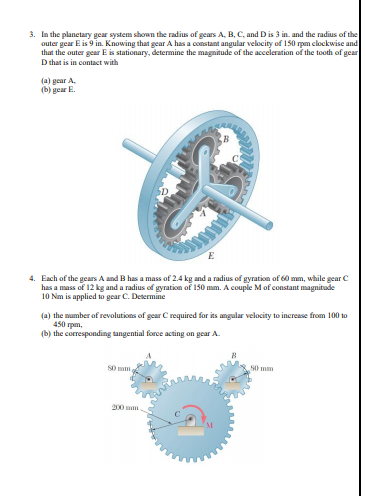3. In the planctary gear system shown the radius of gears A, B, C, and Dis 3 in. and the radius of the outer gear E is 9 in. Knowing that gear A has a constant angular velocity of 150 rpm clockwise and that the outer gear Eis stationary, determine the magnitude of the acceleration of the tooth of gear Dthat is in contact with (a) gear A. (b) gear E. SD
3. In the planctary gear system shown the radius of gears A, B, C, and Dis 3 in. and the radius of the outer gear E is 9 in. Knowing that gear A has a constant angular velocity of 150 rpm clockwise and that the outer gear Eis stationary, determine the magnitude of the acceleration of the tooth of gear Dthat is in contact with (a) gear A. (b) gear E. SD
Elements Of Electromagnetics
7th Edition
ISBN:9780190698614
Author:Sadiku, Matthew N. O.
Publisher:Sadiku, Matthew N. O.
ChapterMA: Math Assessment
Section: Chapter Questions
Problem 1.1MA
Related questions
Question

Transcribed Image Text:3. In the planetary gear system shown the radius of gears A, B, C, and Dis 3 in. and the radius of the
outer gear E is 9 in. Knowing that gear A has a constant angular velocity of 150 rpm clockwise and
that the outer gear E is stationary, determine the magnitude of the acceleration of the tooth of gear
D that is in contact with
(a) gear A.
(b) gear E.
4. Each of the gears A and B has a mass of 2.4 kg and a radius of gyration of 60 mm, while gear C
has a mass of 12 kg and a radius of gyration of 150 mm. A couple Mof constant magnitude
10 Nm is applied to gear C. Determine
(a) the mumber of revolutions of gear C required for its angular velocity to increase from 100 to
450 rpm,
(b) the corresponding tangential force acting on gear A.
S0 mm,
S0 mm
200 mm
Expert Solution
This question has been solved!
Explore an expertly crafted, step-by-step solution for a thorough understanding of key concepts.
This is a popular solution!
Trending now
This is a popular solution!
Step by step
Solved in 2 steps with 5 images

Knowledge Booster
Learn more about
Need a deep-dive on the concept behind this application? Look no further. Learn more about this topic, mechanical-engineering and related others by exploring similar questions and additional content below.Recommended textbooks for you

Elements Of Electromagnetics
Mechanical Engineering
ISBN:
9780190698614
Author:
Sadiku, Matthew N. O.
Publisher:
Oxford University Press

Mechanics of Materials (10th Edition)
Mechanical Engineering
ISBN:
9780134319650
Author:
Russell C. Hibbeler
Publisher:
PEARSON

Thermodynamics: An Engineering Approach
Mechanical Engineering
ISBN:
9781259822674
Author:
Yunus A. Cengel Dr., Michael A. Boles
Publisher:
McGraw-Hill Education

Elements Of Electromagnetics
Mechanical Engineering
ISBN:
9780190698614
Author:
Sadiku, Matthew N. O.
Publisher:
Oxford University Press

Mechanics of Materials (10th Edition)
Mechanical Engineering
ISBN:
9780134319650
Author:
Russell C. Hibbeler
Publisher:
PEARSON

Thermodynamics: An Engineering Approach
Mechanical Engineering
ISBN:
9781259822674
Author:
Yunus A. Cengel Dr., Michael A. Boles
Publisher:
McGraw-Hill Education

Control Systems Engineering
Mechanical Engineering
ISBN:
9781118170519
Author:
Norman S. Nise
Publisher:
WILEY

Mechanics of Materials (MindTap Course List)
Mechanical Engineering
ISBN:
9781337093347
Author:
Barry J. Goodno, James M. Gere
Publisher:
Cengage Learning

Engineering Mechanics: Statics
Mechanical Engineering
ISBN:
9781118807330
Author:
James L. Meriam, L. G. Kraige, J. N. Bolton
Publisher:
WILEY